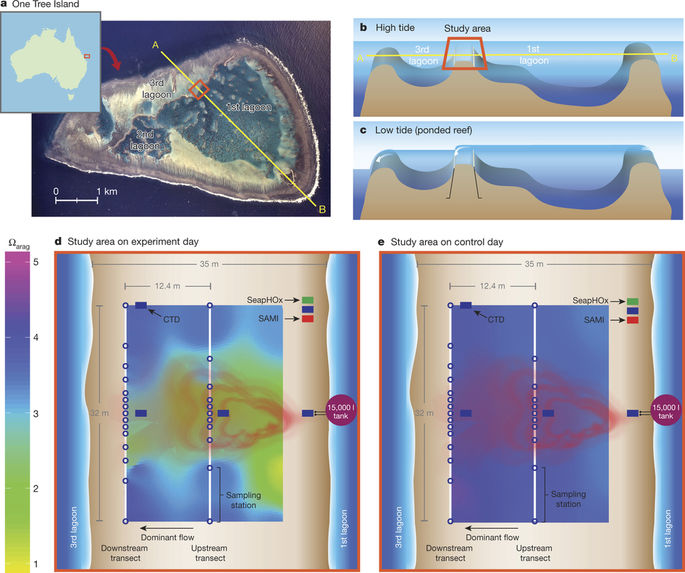Our official English website, www.x-mol.net, welcomes your
feedback! (Note: you will need to create a separate account there.)
Carbon dioxide addition to coral reef waters suppresses net community calcification
Nature ( IF 50.5 ) Pub Date : 2018-03-01 , DOI: 10.1038/nature25968 Rebecca Albright , Yuichiro Takeshita , David A. Koweek , Aaron Ninokawa , Kennedy Wolfe , Tanya Rivlin , Yana Nebuchina , Jordan Young , Ken Caldeira
Nature ( IF 50.5 ) Pub Date : 2018-03-01 , DOI: 10.1038/nature25968 Rebecca Albright , Yuichiro Takeshita , David A. Koweek , Aaron Ninokawa , Kennedy Wolfe , Tanya Rivlin , Yana Nebuchina , Jordan Young , Ken Caldeira

|
Coral reefs feed millions of people worldwide, provide coastal protection and generate billions of dollars annually in tourism revenue. The underlying architecture of a reef is a biogenic carbonate structure that accretes over many years of active biomineralization by calcifying organisms, including corals and algae. Ocean acidification poses a chronic threat to coral reefs by reducing the saturation state of the aragonite mineral of which coral skeletons are primarily composed, and lowering the concentration of carbonate ions required to maintain the carbonate reef. Reduced calcification, coupled with increased bioerosion and dissolution, may drive reefs into a state of net loss this century. Our ability to predict changes in ecosystem function and associated services ultimately hinges on our understanding of community- and ecosystem-scale responses. Past research has primarily focused on the responses of individual species rather than evaluating more complex, community-level responses. Here we use an in situ carbon dioxide enrichment experiment to quantify the net calcification response of a coral reef flat to acidification. We present an estimate of community-scale calcification sensitivity to ocean acidification that is, to our knowledge, the first to be based on a controlled experiment in the natural environment. This estimate provides evidence that near-future reductions in the aragonite saturation state will compromise the ecosystem function of coral reefs.
中文翻译:

向珊瑚礁水域添加二氧化碳抑制净群落钙化
珊瑚礁为全世界数百万人提供食物,提供海岸保护并每年产生数十亿美元的旅游收入。珊瑚礁的底层结构是一种生物碳酸盐结构,它通过钙化生物(包括珊瑚和藻类)在多年活跃的生物矿化作用下积聚。海洋酸化降低了构成珊瑚骨架的主要文石矿物的饱和状态,并降低了维持碳酸盐礁所需的碳酸根离子浓度,从而对珊瑚礁构成了长期威胁。钙化的减少,加上生物侵蚀和溶解的增加,可能会使珊瑚礁在本世纪进入净损失状态。我们预测生态系统功能和相关服务变化的能力最终取决于我们对社区和生态系统规模响应的理解。过去的研究主要集中在单个物种的反应上,而不是评估更复杂的社区级反应。在这里,我们使用原位二氧化碳富集实验来量化珊瑚礁平面对酸化的净钙化反应。我们提出了对海洋酸化的社区规模钙化敏感性的估计,据我们所知,这是第一个基于自然环境中的受控实验。这一估计提供了证据,表明近期文石饱和状态的减少将损害珊瑚礁的生态系统功能。过去的研究主要集中在单个物种的反应上,而不是评估更复杂的社区级反应。在这里,我们使用原位二氧化碳富集实验来量化珊瑚礁平面对酸化的净钙化反应。我们提出了对海洋酸化的社区规模钙化敏感性的估计,据我们所知,这是第一个基于自然环境中的受控实验。这一估计提供了证据,表明近期文石饱和状态的减少将损害珊瑚礁的生态系统功能。过去的研究主要集中在单个物种的反应上,而不是评估更复杂的社区级反应。在这里,我们使用原位二氧化碳富集实验来量化珊瑚礁平面对酸化的净钙化反应。我们提出了对海洋酸化的社区规模钙化敏感性的估计,据我们所知,这是第一个基于自然环境中的受控实验。这一估计提供了证据,表明近期文石饱和状态的减少将损害珊瑚礁的生态系统功能。我们提出了对海洋酸化的社区规模钙化敏感性的估计,据我们所知,这是第一个基于自然环境中的受控实验。这一估计提供了证据,表明近期文石饱和状态的减少将损害珊瑚礁的生态系统功能。我们提出了对海洋酸化的社区规模钙化敏感性的估计,据我们所知,这是第一个基于自然环境中的受控实验。这一估计提供了证据,表明近期文石饱和状态的减少将损害珊瑚礁的生态系统功能。
更新日期:2018-03-01
中文翻译:

向珊瑚礁水域添加二氧化碳抑制净群落钙化
珊瑚礁为全世界数百万人提供食物,提供海岸保护并每年产生数十亿美元的旅游收入。珊瑚礁的底层结构是一种生物碳酸盐结构,它通过钙化生物(包括珊瑚和藻类)在多年活跃的生物矿化作用下积聚。海洋酸化降低了构成珊瑚骨架的主要文石矿物的饱和状态,并降低了维持碳酸盐礁所需的碳酸根离子浓度,从而对珊瑚礁构成了长期威胁。钙化的减少,加上生物侵蚀和溶解的增加,可能会使珊瑚礁在本世纪进入净损失状态。我们预测生态系统功能和相关服务变化的能力最终取决于我们对社区和生态系统规模响应的理解。过去的研究主要集中在单个物种的反应上,而不是评估更复杂的社区级反应。在这里,我们使用原位二氧化碳富集实验来量化珊瑚礁平面对酸化的净钙化反应。我们提出了对海洋酸化的社区规模钙化敏感性的估计,据我们所知,这是第一个基于自然环境中的受控实验。这一估计提供了证据,表明近期文石饱和状态的减少将损害珊瑚礁的生态系统功能。过去的研究主要集中在单个物种的反应上,而不是评估更复杂的社区级反应。在这里,我们使用原位二氧化碳富集实验来量化珊瑚礁平面对酸化的净钙化反应。我们提出了对海洋酸化的社区规模钙化敏感性的估计,据我们所知,这是第一个基于自然环境中的受控实验。这一估计提供了证据,表明近期文石饱和状态的减少将损害珊瑚礁的生态系统功能。过去的研究主要集中在单个物种的反应上,而不是评估更复杂的社区级反应。在这里,我们使用原位二氧化碳富集实验来量化珊瑚礁平面对酸化的净钙化反应。我们提出了对海洋酸化的社区规模钙化敏感性的估计,据我们所知,这是第一个基于自然环境中的受控实验。这一估计提供了证据,表明近期文石饱和状态的减少将损害珊瑚礁的生态系统功能。我们提出了对海洋酸化的社区规模钙化敏感性的估计,据我们所知,这是第一个基于自然环境中的受控实验。这一估计提供了证据,表明近期文石饱和状态的减少将损害珊瑚礁的生态系统功能。我们提出了对海洋酸化的社区规模钙化敏感性的估计,据我们所知,这是第一个基于自然环境中的受控实验。这一估计提供了证据,表明近期文石饱和状态的减少将损害珊瑚礁的生态系统功能。











































 京公网安备 11010802027423号
京公网安备 11010802027423号